Multiple Choice
Data from gapminder.org on 184 countries was used to examine if there is an association between (average) female life expectancy (that is, the average lifespan of women in the country) and the average number of children women give birth to for the year 2019. A scatterplot of the data follows. 
-Select the best explanation for how one sample would be simulated in order to generate the null distribution.
A) Holding the average number of children constant, randomize the order of the female life expectancies. Plot the correlation coefficient of the shuffled data on the null distribution.
B) Add or subtract the appropriate value from each average number of children and female life expectancy in order to force the null hypothesis to be true. Plot the correlation coefficient of the shifted data on the null distribution.
C) Flip a coin to decide whether to swap the values for average number of children and female life expectancy or not. Plot the correlation coefficient of the randomized points on the null distribution.
D) Put each pair of (average number of children, female life expectancy) on a piece of paper. Draw with replacement 40 times. Plot the correlation coefficient of the resampled data on the null distribution.
Correct Answer:

Verified
Correct Answer:
Verified
Q43: Annual measurements of the number of powerboat
Q44: Data from gapminder.org on 184 countries was
Q45: Babies born with low birth weights (less
Q46: Data from gapminder.org on 184 countries was
Q47: Are people with bigger brains more intelligent?
Q49: The graph below shows a scatter plot
Q50: The following scatterplot displays the finish time
Q51: Social warmth is a term referring to
Q52: Annual measurements of the number of powerboat
Q53: Which of the following correlation coefficient values